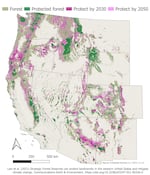
Mount Jefferson is the dominant feature of the Mount Jefferson Wilderness area, where more than 100,000 acres of forestland is protected from logging, grazing and mining.
Steve Lundeberg
Researchers with Oregon State University say the U.S. needs to establish new “Strategic Forest Reserves” to protect wildlife and reduce the carbon emissions that contribute to climate change.
A new study maps the Western forests that would store the most carbon and help the most species if they were given the same level of protection from logging, grazing and mining as designated wilderness areas receive.
Researchers analyzed which forests are currently protected in 11 states and which ones should be prioritized for protection in the future, outlining a plan for creating Strategic Forest Reserves across the region.
Their findings were published this week in the journal Nature.
The scientists are calling on state, federal and tribal governments as well as private landowners to use their research and protect certain forests to reduce the impacts of climate change and protect biodiversity.
“Policy makers, including those in the Biden administration, frequently talk about the need to protect forests in developing countries,” OSU Professor Emeritus Beverly Law said. “Forests in the Pacific Northwest have enormous carbon storage potential but U.S. public lands are often overlooked.”
Law and other researchers identified how much additional land would need to be protected to meet international climate goals of protecting 30% of land and water by 2030.
The Biden administration has set similar domestic goals to protect 30% of U.S. land and waters by 2030 but has yet to develop a specific plan to do so. Law said she has been sharing her science with the administration.
“We’re saying ‘Look here. Look here.’ Are these good candidates for protection?” Law said.
She said the key forests for storing carbon and protecting species diversity in Oregon and Washington are along the coast.
“We have probably the best forests in the lower 48 states for storing carbon and continuing to accumulate carbon because these trees live 800 years or more in the Northwest,” she said.

Researchers with Oregon State University have mapped the forests in the Western U.S. that should be the highest priority for protection by 2030 and 2050 to meet climate goals.
Courtesy of Beverly Law
In previous research, Law found that not logging certain forests would store more of the carbon that contributes to climate change while also reducing carbon emissions from logging.
“When you have a disturbance such as fire, and when wood is removed and harvested and put into wood products, you have to follow the carbon,” she said. “And it turns out that … harvest-related emissions are five to seven times that of the fire emissions in Oregon.”
Nick Smith, public affairs director with the American Forest Resource Council, said creating protected reserves will not reduce the risk of severe wildfires that will emit carbon from the forest. He said severe wildfires have hurt species such as the northern spotted owl by burning forest habitat.
”Climate change requires actively managing forests for mitigation and adaptation, as well as to maintain healthy, growing trees needed to remove carbon dioxide from the atmosphere,” Smith said in a response to the proposed reserves. His organization is a trade association that advocates for timber harvests on public timberlands in the West.
For her latest study, Law and her colleagues analyzed data on biodiversity, carbon storage and vulnerability to drought and wildfire in forests across the Western U.S. to determine which forests should be high priorities for protection. They also looked at how much carbon the forests could potentially store by 2030 and 2050.
They found the best forests for storing carbon and protecting imperiled species are mostly on federal land, where government agencies or elected officials could use executive action, regulation or rulemaking to install permanent protections. That could mean banning logging, mining and grazing indefinitely.
“The key to this is that it needs to be permanent,” Law said. “That means you’re going to keep the carbon there. You’re not going to cut the forest. The high carbon density forests are mature and older forest.”
Law said older forests can store more carbon in trees, plants and soil, and they are also valuable places for large, threatened carnivores such as the gray wolf and Canada lynx. Protecting certain forests strategically could help address both climate change and biodiversity concerns, she said.
“What it provides is protection from human influences,” she said. “We tend to mess things up. So, this allows those forests to continue to grow. It’s the reservoir. We obviously have to reduce our fossil fuel emissions, but we also need to protect the reservoirs of carbon in the ocean and on the land.”
Researchers also found a significant amount of the high priority lands are on private land, where they say governments could offer incentives and support voluntary protections or the land could be purchased for conservation.
Law said they also looked at the data on a state level and found Oregon only has the highest level of protection for 7% of its forestland.
“That’s nothing,” Law said. “We’re not doing so well compared to other states. When we look at how much states have put aside for protection, Oregon comes in last, surprisingly.”
The Oregon Department of Forestry declined to comment. A spokesperson from Gov. Kate Brown said her office is still reviewing the research and would likely need to talk with federal, local and tribal governments as well as stakeholders about the forest reserve proposals.
